Bill Self 1-3-1
 | 1 Bill Self 3 is right-handed, he inbounds about 3 feet behind the baseline on the left, better to run the baseline and pass. He is not in a hurry to get the ball when the other team scores, but the other four players sprint into position. Against a "hot" press you don't want to inbounds to the guards, they are decoys. Bypass the guards and throw long, then hit guards cutting in the middle. If the defence is sucked in (e.g., denying), throw over the top, even an incomplete deep pass can stretch the defence. As soon as 3 gets both feet out of bounds, 4 flashes back and angles in to cut off his defender, get the ball as high as possible and square up. Automatically the nearest guard cuts 45 degrees to the sideline, the other guard follows to the middle always ahead of the ball. The passer steps in ballside. If 5 doesn't get the inbounds pass, he leaves and is the throw-over man opposite the ball. Against a hot press think layups, against a soft press think numbers, e.g., 3 on 2 or 2 on 1. |
 | 2 After the inbounds pass there is a 1-3-1 set. The short passes should be about 15-18 feet. If 4 passes up the sideline, try to get the ball to the middle and have numbers. |
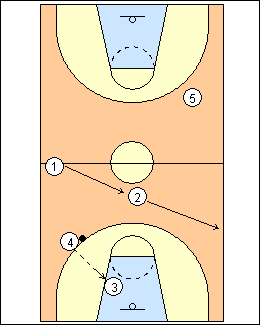 | 3 If 4 passes to 3 (the last option), 2 cuts to the sideline, 1 flashes to the middle to maintain a 1-3-1. Run to open areas not spots. |
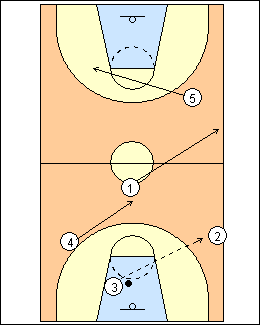 | 4 If 3 reverses to 2, 1 cuts up the ballside sideline, 4 goes middle ahead of the ball, 5 moves opposite the ball, allowing a 3-man attack on a pass to 1 or 4. |
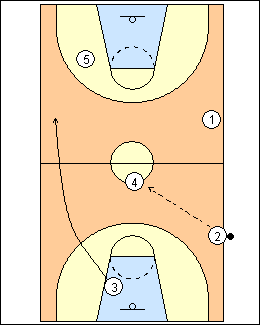 | 5 On a pass to the middle, the trailer runs wide opposite, the passer becomes the new trailer. |
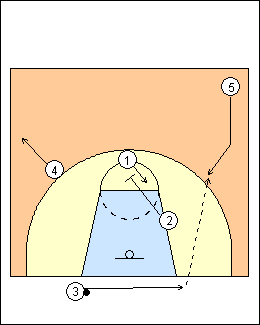 | 6 If 4 isn't open, 3 runs the baseline, 5 is the target, but he does not run below the foul-line extended. 4 gets back out a little. As soon as 3 crosses the lane line running towards 5, 1 and 2 have to get open, e.g., 2 drop pivots and screens for 1 then steps back to the ball (2 starts at the second marker). They can stack. |
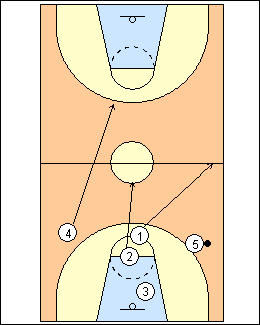 | 7 The rules are the same, the nearest guard goes to the ballside sideline (facing in), 4 is now the finisher (throw-over man). |
 | 8 However, if 5 (the worst ballhandler) passes, he is out of the play, 1 and 4 come back towards the ball for a 1-3-1. |
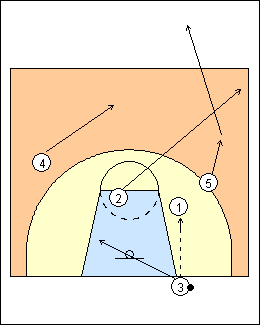 | 9 If 5 is denied he steps back and gets out of the way, 3 can inbound to 1 (or run back to pass to 4), 5 goes long, 4 cuts middle, 2 cuts ballside sideline, 3 could be trailer or weakside for a 1-3-1. |
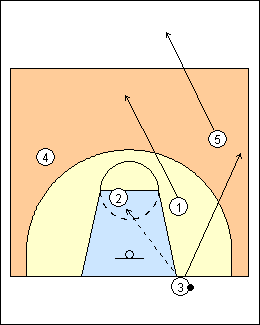 | 10 If 3 inbounds to 2 in the lane, 1 cuts middle, 3 goes ballside sideline, 5 goes deep for the easiest 1-3-1. 2 is the trailer. |
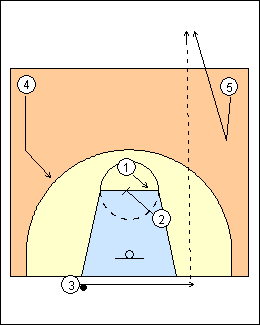 | 11 When 3 runs the baseline and 5 is denied, on a signal (e.g., eye contact) 5 can take two steps towards the ball (right-left), then make a crossover step and go long (a v-cut). This can be done by 4 if he is denied, but usually happens with 5. |
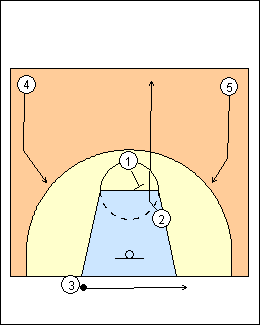 | 12 Special "2" 4 comes up and stays, 3 runs the baseline, 5 comes hard and stays, 2 acts like he is going to screen then 1 screens for 2 to go long. |
 | 13 On a "spot" inbounds play where 3 can't run the baseline, 2 is ballside. 4 angles in then backs out a little, 2 screens for 1 after a two-count, 5 may have to come all the way back. 3 comes in ballside so there is no easy basket on a mistake. 1 and 2 will cut sideline and middle, 4 is the finisher. If the inbounds play is on the other side of the lane, flip-flop 4 and 5 if 5 can't catch or shoot free throws. |
This page was made with Basketball playbook from Jes-Soft